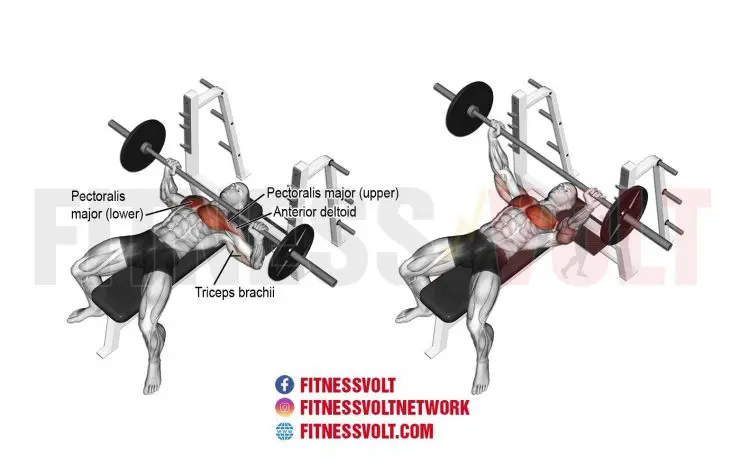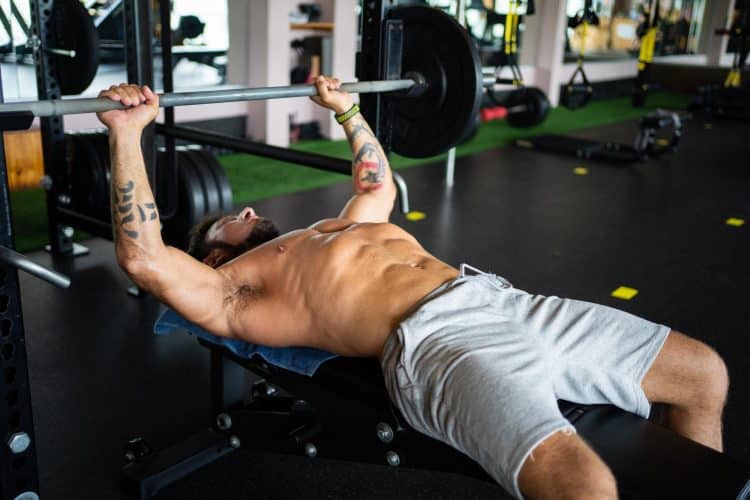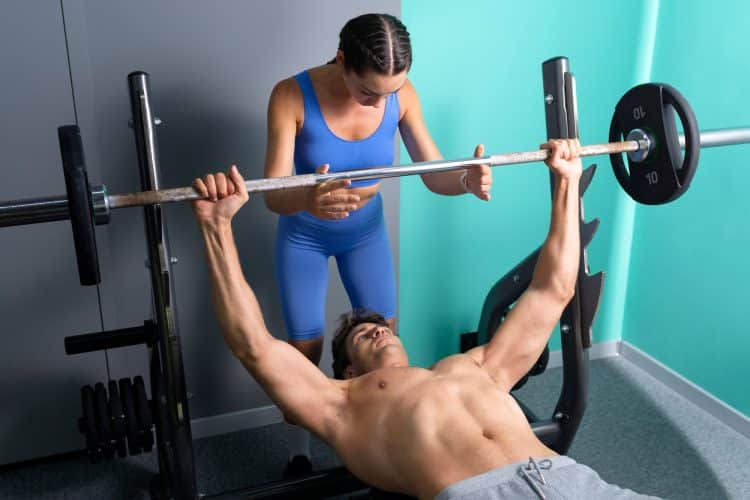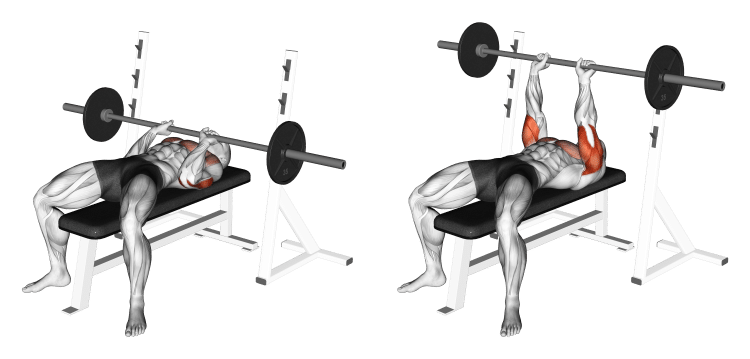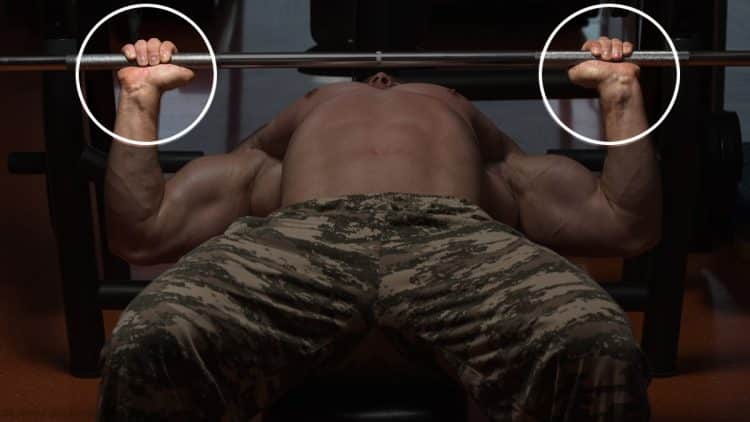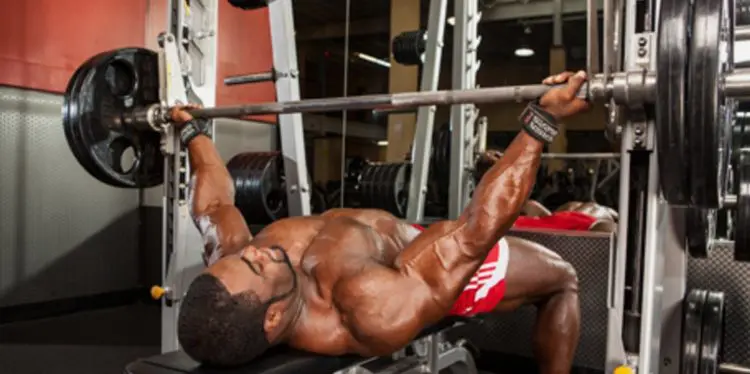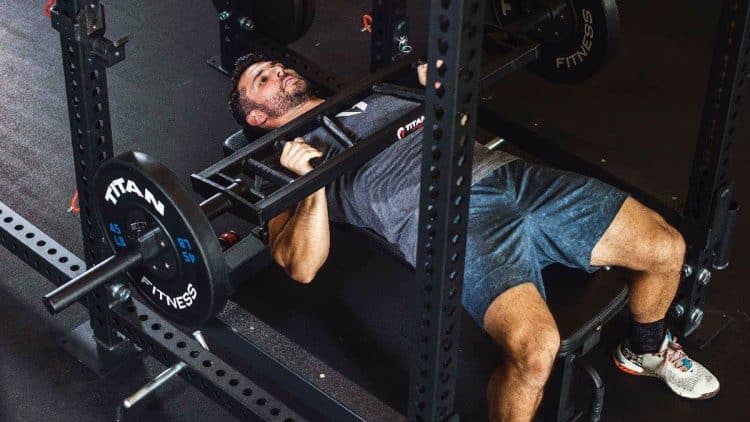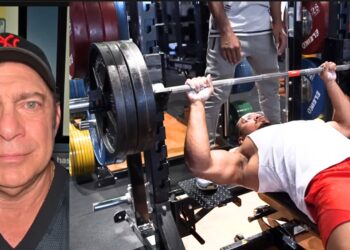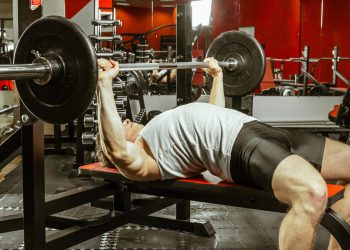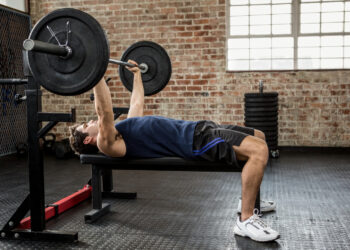The barbell bench press is the world’s favorite upper-body exercise. Go to any gym, and there will probably be a queue for the bench press station. Get any two lifters together, and invariably, one will ask the other, “bro, how much can you bench?”
Bodybuilders do bench presses to develop their pecs, while powerlifters use the bench press to build and test their strength. Gym bros do bench presses for social media likes, fake weights, and all! Even non-exercisers can usually identify the bench press, even if they don’t know how to do it correctly.
However, the bench press is a multifaceted exercise, and there are several different ways to do them. Your options include the following:
- Regular, incline, or decline
- Arched back (powerlifting style)
- Feet elevated (bodybuilding style)
- Paused
- Dead-stop
- Explosive
- Eccentric
- With bands or chains
- On a Smith machine
There are also several different grips you can use to target specific muscles, increase your performance, or just for variation.
In this article, we examine the six main grips you can use for barbell bench presses.
What Is the Bench Press?
Most lifters are very familiar with the mighty bench press, so you can skip this section if you are already a certified bench press expert! But, if you are not an experienced gym-goer, you may find the following information interesting…
Level Up Your Fitness: Join our 💪 strong community in Fitness Volt Newsletter. Get daily inspiration, expert-backed workouts, nutrition tips, the latest in strength sports, and the support you need to reach your goals. Subscribe for free!
The bench press is a relatively new exercise. In fact, it’s only been around since the 1940s. Before that, most pressing was done overhead. If you wanted to do a horizontal pressing movement, you did it on the deck, i.e., floor presses.
However, with the advent of mass-produced weight training benches, the bench press soon became popular and was quickly adopted by bodybuilders, weightlifters, powerlifters, strongmen, and physical culturists all over the world.
The barbell bench press is a compound upper-body pushing exercise. As such, it involves several joints and muscles working together. The main muscles trained during bench presses are:
Pectoralis major
Known as the pecs for short, this large fan-shaped muscle covers most of your chest. In fact, if you want a bigger chest, the bench press is one of the best ways to build it. The functions of the pecs include horizontal flexion, medial rotation, and adduction of the shoulder joint.
Because of the alignment of the pec fibers, you can target different parts of your chest by using different bench-pressing angles. For example, incline bench presses hit your upper chest, while decline bench presses work your lower chest more.
Deltoids
The deltoids are your primary shoulder muscles. There are three groups of deltoid fibers called heads: Anterior (front), posterior (rear), and medial (middle). While all three heads are involved in bench presses, the anterior head is the most active. The medial and posterior heads work mainly as stabilizers, minimizing unwanted shoulder movements.
Rotator cuff
The rotator cuff is a group of four small muscles that control and stabilize your shoulder joint. These muscles are the supraspinatus, infraspinatus, teres minor, and subscapularis. While these muscles are small, they are very important during bench presses and help prevent extraneous movement. A weak rotator cuff will hurt your bench press performance and could lead to injuries.
Serratus anterior
The serratus anterior is so-called because it looks like the jagged edge of a knife or sawblade. Located to the side of your chest, this muscle pulls your scapular in and down onto your posterior ribs. Strong serratus anterior muscles help stabilize your shoulder girdle for a bigger, stronger, more stable bench press.
Latissimus dorsi
Yes, the lats ARE a back muscle, but they play an essential role during bench presses all the same. The lats adduct your shoulder, pulling your upper arms down and toward your sides. Depending on the type of grip used, your lats can contribute a little or a lot of strength to the bench press. Strong lats are critical for a heavy bench press.
Triceps
Located on the back of your upper arms, the triceps extend your elbows, so they’re very active during bench presses. In fact, for many lifters, the triceps are the limiting muscle group during bench presses.
Depending on your grip, you can emphasize different muscles during the bench press. So, you need to choose the best hand position for your goals.
How to do Bench Press
Some lifters report that bench presses give them shoulder pain, so it’s essential you perform this exercise correctly. Poor form increases your risk of suffering an injury. So, follow these steps to bench press like a boss!
- Lie on your bench, so your eyes are directly beneath the barbell.
- Reach up and grasp the bar with your chosen grip.
- Press your glutes, upper back, and head into the bench and push your feet into the floor. Brace your core, and squeeze your shoulders down and back. This will create a stable upper back and slight arch in your lumbar spine.
- Unrack the bar and then hold it directly over your shoulders.
- Take a big breath in, fully inflating your chest.
- Bend your arms and lower the bar down toward the highest point of your chest. The descent should be controlled but not super-slow.
- Let the bar lightly touch your chest. No bouncing!
- Drive the bar up and off your chest and back toward your shoulders. Try to lift the bar faster than you lowered it.
- Push the bar back up to the starting position and then exhale.
- Inhale, reset your core, and perform another repetition.
Depending on your chosen grip, you may have to adopt a slightly different bench press technique to the one described above.
Six Different Bench Press Grips
Don’t just grab and go! Pick your bench press grip carefully so that you get the results you want from this popular upper-body pushing exercise.
- Medium-grip bench press
- Wide-grip bench press
- Close-grip bench press
- Thumbless grip
- Reverse-grip bench press
- Neutral-grip bench press
1. Medium-grip bench press
The medium grip is probably the most widely used hand position for bench presses. It’s what most lifters automatically gravitate toward for the bench press. Also known as the standard or regular grip, the medium-grip bench press is comfortable, feels natural, and provides a good position for building muscle or developing strength.
Your hand position for medium grip bench presses depends on the length of your arms but is usually just outside shoulder-width apart. Most barbells have knurled rings to make putting your hands in the same position easier. At the bottom of the medium grip bench press, when the bar is touching your chest, your forearms should be vertical.
Benefits:
- The best option for general bodybuilding and strength training.
- Easy to learn.
- Relatively comfortable and safe.
- Works all regions of the chest equally.
- Works the chest and triceps equally.
2. Wide-grip bench press
Wide grip bench presses involve putting your hands about one and a half shoulder widths apart, although some lifters may put their hands wider than this. This wide hand position increases the range of motion at your shoulder joint while reducing the ROM at your elbows.
This means your pecs have more work to do compared to medium-grip bench presses, and your triceps do a little less. Bodybuilders use wide-grip bench presses to increase chest engagement. In contrast, some powerlifters may use it as it allows them to lift heavier weights.
However, wide-grip bench presses also tend to put more stress on your joints, so they are best avoided by lifters with pre-existing shoulder problems.
Benefits:
- The weight doesn’t have to travel as far, so you may be able to lift heavier weights.
- More chest-centric than medium-grip bench presses.
- Targets the upper and outer chest a little more.
- The wide grip makes it easier to set your shoulders and keep them down and back.
Read more on wide-grip bench press.
3. Close-grip bench press
The close grip bench press is more of a triceps exercise than a chest exercise. Your hands are inside shoulder-width apart, and some people even place their hands so their thumbs are touching.
Rather than flaring your arms outward, with close-grip bench presses, the elbows tend to travel forward, which increases triceps activation even more.
Level Up Your Fitness: Join our 💪 strong community in Fitness Volt Newsletter. Get daily inspiration, expert-backed workouts, nutrition tips, the latest in strength sports, and the support you need to reach your goals. Subscribe for free!
Bodybuilders do close-grip bench presses to build bigger arms, while powerlifters use them as an assistance exercise to build stronger triceps and increase their regular bench press performance.
Close-grip bench presses tend to be quite shoulder-friendly. However, using a very narrow grip can put excessive stress on the wrists and elbows. As such, it’s generally best to use a moderately close grip and not bring your hands in so close that they touch.
Benefits:
- A very effective triceps mass builder.
- Easy on the shoulders.
- Good for boosting regular bench press performance.
Read more on close-grip bench press.
4. Thumbless grip
When it comes to holding the barbell for bench presses, regardless of whether you use a close, medium, or wide grip, you have another choice to make. Should you wrap your thumbs around the bar and use a full grip, or hold the bar without using your thumbs, which is the so-called thumbless or suicide grip.
While the thumbless option does provide a slightly less secure grip on the bar, a lot of lifters prefer it to the full grip. Even bodybuilding legend Arnold Schwarzenegger confessed to using it while training for his many Mr. Olympia titles.
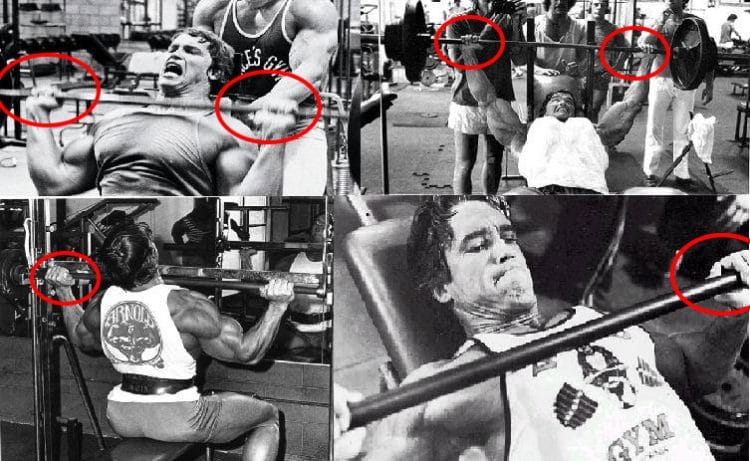
The thumbless grip may feel more comfortable and allows you to place the bar more over your forearm, so there is less strain on your wrists. Also, the thumbless grip means you can rotate your arms slightly inward, making it easier to tuck your elbows during medium and close bench presses.
While there is a greater risk of dropping the bar, which would cause serious injury, many veteran lifters have used the thumbless grip without accident for decades. You just have to be more careful.
If you do use a thumbless grip for bench pressing, make sure you always have a spotter on hand, use gym chalk to stop the bar from slipping, and take care when unracking and reracking the bar, which is when most accidents happen.
However, it’s worth noting that the thumbless grip is not legal in powerlifting competitions, which is why so many powerlifters rely on wrist wraps to support and keep their wrists straight.
Benefits:
- Increased comfort as the bar rests on a more padded part of your hands.
- Less joint strain as it’s easier to keep your wrists straight.
- Less shoulder stress as you can rotate your arms into a more biomechanically comfortable position.
- Easier to tuck your elbows into your sides during medium and close-grip bench presses.
- Can be used for most bench press and overhead press variations.
Read more on suicide grip bench press.
5. Reverse-grip bench press
Regardless of whether you use a thumbless or full grip, you probably hold the barbell with your palms pronated or in an overhand grip. This is the most comfortable and natural way to perform bench presses.
However, many old-school and some forward-thinking modern lifters use a reverse grip for bench presses, holding the bar with their hands in a supinated position.
This bench press grip option is thought to increase upper chest engagement and works the upper pecs as well as incline bench presses. In fact, studies suggest that the reverse grip bench press can increase upper pec recruitment by as much as 30% while also increasing biceps activation (1).
The reverse grip bench press can take some getting used to, especially if you usually use an overhand grip. And they’re not especially comfortable. That said, it could be an excellent option if you want to work your upper chest and don’t have access to an incline bench.
Benefits:
- Less stress on the shoulders.
- Increased upper chest engagement.
- It may allow you to lift heavier weights.
- An excellent alternative to conventional bench presses.
Read more on reverse grip bench press.
6. Neutral-grip bench press
The previous five grip options (medium, wide, close, thumbless, and reverse) all use a standard barbell – Olympic or otherwise. However, you’ll need a Swiss or football bar to perform bench presses with a neutral or palms-in grip.
Football bars have several neutral handles set at varying widths, so you can do bench presses with your palms facing inward instead of pronated or supinated.
The name football bar comes from the NFL, where players are notorious for having banged-up shoulders. Swiss bars are very popular with football players, and bench pressing with a football bar is usually more shoulder-friendly than a straight barbell.
While you can do neutral grip dumbbell bench presses, it’s not always easy to control a pair of weights instead of one. Getting heavy weights into the correct position to start your set can also be a real challenge.
Most football bars fit the uprights of a bench press station or power rack and are much better for heavy strength training. They’re also easier to spot than heavy dumbbells.
Benefits:
- Can be used for close, medium, or wide-grip bench presses.
- More shoulder-friendly than a straight bar.
- You can also use a thumbless grip.
- Suitable for lifters with mild to moderate shoulder pain who still want to bench press.
Read more best Swiss bar exercises.
Which Barbell Bench Press Grip Is Right for You?
So, which bench press grip should you use? The answer actually depends on you and why you are bench pressing.
Bodybuilders may want to use a wide grip to increase pec development or a close grip to target their triceps more. In contrast, powerlifters might prefer to use a medium grip, which tends to be the strongest.
Lifters with banged-up shoulders will probably do best with neutral grip bench presses but may also get some relief from a close or even an underhand grip.
And then there’s the choice between a full or thumbless grip, which is more a matter of personal preference. If the suicide grip feels more comfortable for your wrists and shoulders, then make it your go-to grip option. But, if you want a more secure hold on the bar, wrap your thumbs around it and use a full grip.
The bottom line is you shouldn’t just DO bench presses. Instead, pick the grip and variation that best matches your goals. This may change over time and your training goals evolve.
Barbell Bench Press Grips – Closing Thoughts
A lot of lifters think they know how to bench press. They lie down on the bench, grab the bar with no real idea of the importance of their hand position, and then drop and bounce the barbell off their chests. Or, they let their spotters do all the work, and then claim they’ve just benched 315 “for reps, bro!”
It’s no wonder that so many have bad shoulders from bench pressing.
Don’t be a sheep and follow the crowd. Instead, stop and think about why you are bench pressing in the first place. Adapt your bench press technique to match your goal. Use the correct grip to maximize performance and comfort.
And remember, there are lots of different ways to perform bench presses, including paused, explosive, slow eccentrics, and from a dead stop. Use the variations and grip options that allow you to achieve your training goals faster.
References:
- Lehman GJ. The influence of grip width and forearm pronation/supination on upper-body myoelectric activity during the flat bench press. J Strength Cond Res. 2005 Aug;19(3):587-91. doi: 10.1519/R-15024.1. PMID: 16095407. https://pubmed.ncbi.nlm.nih.gov/16095407/


